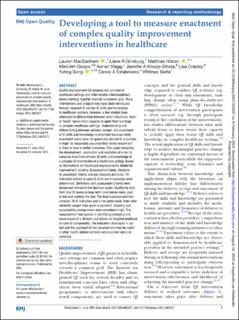| dc.contributor.author | Maceachern, Lauren | |
| dc.contributor.author | Ginsburg, Liane R. | |
| dc.contributor.author | Hoben, Matthias | |
| dc.contributor.author | Doupe, Malcolm | |
| dc.contributor.author | Wagg, Adrian | |
| dc.contributor.author | Knopp-Sihota, Jennifer A. | |
| dc.contributor.author | Cranley, Lisa | |
| dc.contributor.author | Song, Yuting | |
| dc.contributor.author | Estabrooks, Carole A. | |
| dc.contributor.author | Berta, Whitney | |
| dc.date.accessioned | 2023-09-08T08:09:42Z | |
| dc.date.available | 2023-09-08T08:09:42Z | |
| dc.date.created | 2023-05-25T11:14:51Z | |
| dc.date.issued | 2023 | |
| dc.identifier.citation | BMJ Open Quality. 2023, 12 (1), . | en_US |
| dc.identifier.issn | 2399-6641 | |
| dc.identifier.uri | https://hdl.handle.net/11250/3088120 | |
| dc.description.abstract | Quality improvement (QI) projects are common in healthcare settings and often involve interdisciplinary teams working together towards a common goal. Many interventions and programmes have been introduced through research to convey QI skills and knowledge to healthcare workers, however, a few studies have attempted to differentiate between what individuals ‘learn’ or ‘know’ versus their capacity to apply their learnings in complex healthcare settings. Understanding and differentiating between delivery, receipt, and enactment of QI skills and knowledge is important because while enactment alone does not guarantee desired QI outcomes, it might be reasonably assumed that ‘better enactment’ is likely to lead to better outcomes. This paper describes the development, application and validation of a tool to measure enactment of core QI skills and knowledge of a complex QI intervention in a healthcare setting. Based on the Institute for Healthcare Improvement’s Model for Improvement, existing QI assessment tools, literature on enactment fidelity and our research protocols, 10 indicators related to core QI skills and knowledge were determined. Definitions and assessment criteria were tested and refined in five iterative cycles. Qualitative data from four QI teams in long-term care homes were used to test and validate the tool. The final measurement tool contains 10 QI indicators and a five-point scale. Inter-rater reliability ranged from good to excellent. Usability and acceptability among raters were considered high. This measurement tool assists in identifying strengths and weaknesses of a QI team and allows for targeted feedback on core QI components. The indicators developed in our tool and the approach to tool development may be useful in other health related contexts where similar data are collected. | en_US |
| dc.language.iso | eng | en_US |
| dc.publisher | BMJ Publishing Group | en_US |
| dc.rights | Navngivelse-Ikkekommersiell 4.0 Internasjonal | * |
| dc.rights.uri | http://creativecommons.org/licenses/by-nc/4.0/deed.no | * |
| dc.title | Developing a tool to measure enactment of complex quality improvement interventions in healthcare | en_US |
| dc.type | Peer reviewed | en_US |
| dc.type | Journal article | en_US |
| dc.description.version | publishedVersion | en_US |
| dc.rights.holder | © Author(s) (or their employer(s)) 2023 | en_US |
| dc.source.pagenumber | 7 | en_US |
| dc.source.volume | 12 | en_US |
| dc.source.journal | BMJ Open Quality | en_US |
| dc.source.issue | 1 | en_US |
| dc.identifier.doi | 10.1136/bmjoq-2022-002027 | |
| dc.identifier.cristin | 2149187 | |
| dc.source.articlenumber | e002027 | en_US |
| cristin.ispublished | true | |
| cristin.fulltext | original | |
| cristin.qualitycode | 1 | |

